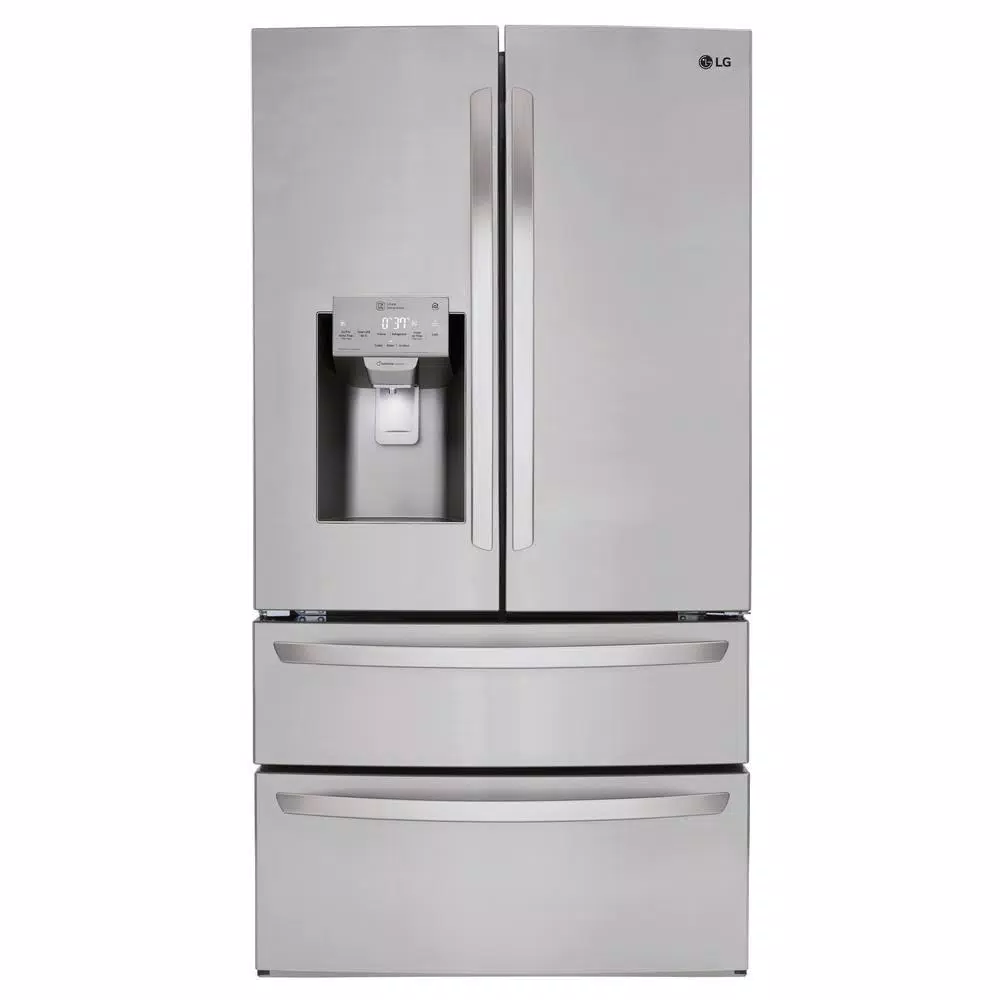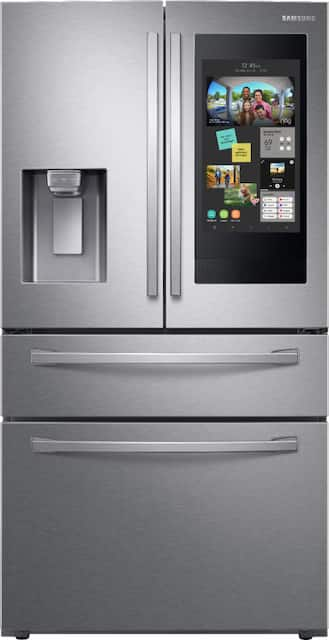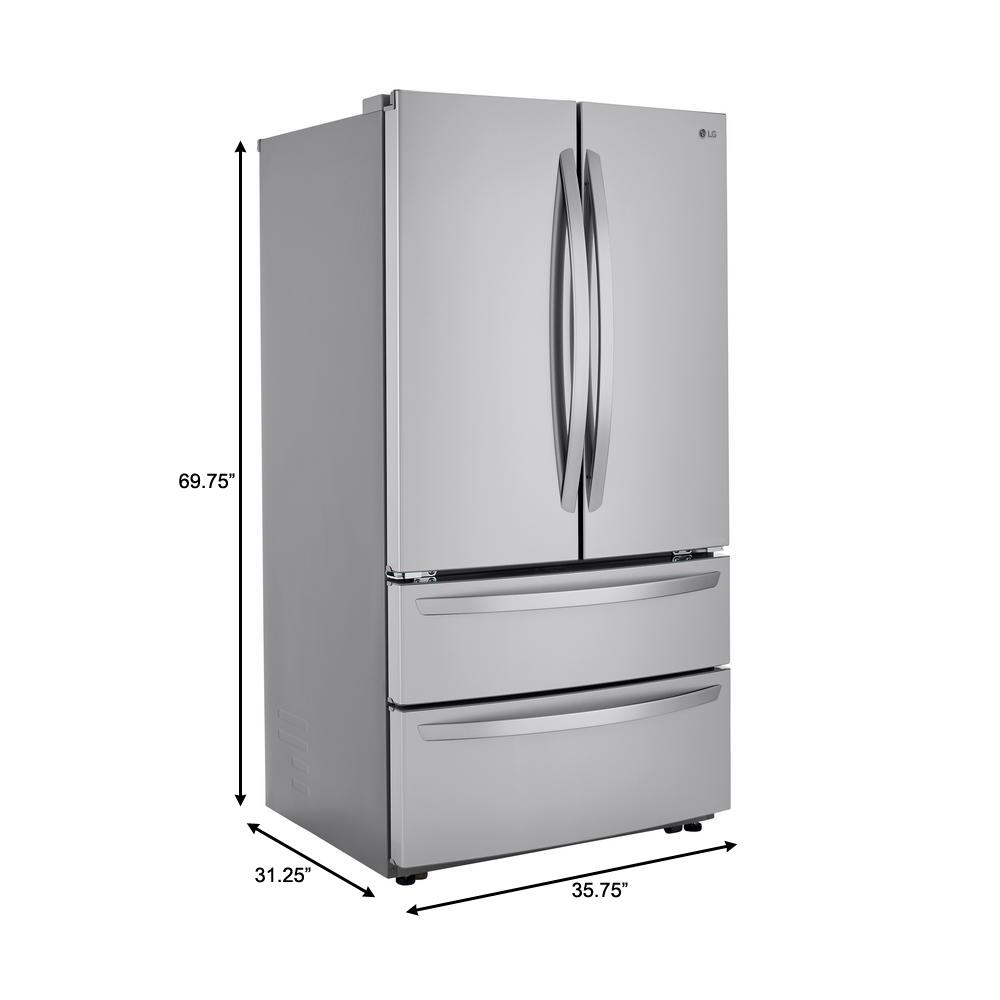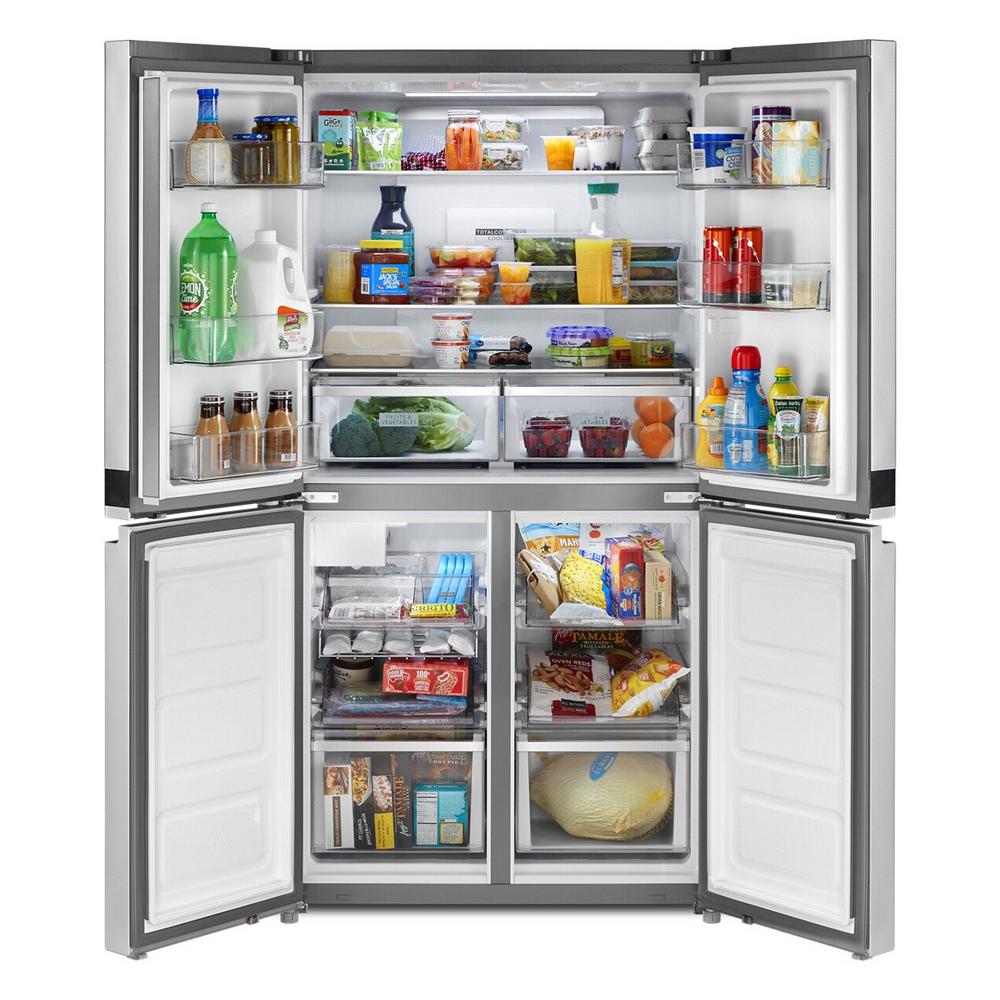LG 27 cu. ft. Side by Side Refrigerator with External Ice & Water Dispenser in Smooth Black Finish
Smooth touch ice dispenser. Sleek, flat-panel design with pocket handles. Door Cooling+ and SpacePlus ice maker.
It’s easy to show off your best side with our redesigned side-by-side refrigerator. The modern exterior includes flat panels, discreet pocket handles and sleek touch controls—all of which speak to your stylish side. For your organized side, there’s top-to-bottom shelving that keeps fresh and frozen foods in easy sight and with easy access. Stock up for the week and store it all in the generous 27 cu. ft. of space.
- Go ahead and stock up—not only does this refrigerator offer a generous 27 cu. ft. of space, but the vertical door design also offers equal access to fresh and frozen foods. Keep items of all sizes where they’re easy to see and reach.
- Take another glimpse every time you walk by this fresh design from LG and take in the contemporary vibe. Flat panels are enhanced with discreet pocket handles that offer easy access.
- Get all the ice you need without sacrificing shelf space. LG’s innovative slim, in-door design frees up freezer shelf space so you can use every inch for storage while still enjoying easy access to ice when you need it.
- Now you can have all of the things you love about stainless, without the need for special cleaners or constant attention. LG’s PrintProof fingerprint and smudge resistant finish easily wipes clean with a soft, dry cloth for a distinctive kitchen that handles real-life in style.
- Dispense everything from chilled filtered water to filtered cubed or crushed ice with just a light touch. This modern update is both beautiful and practical, designed to be easy to clean to stay looking fresh.
- Now you see them, now you don’t—we moved the refrigerator and freezer temperature controls to the inside of the fridge section to keep the exterior pristine while still keeping the controls close at hand.
- Located in the top of the fresh food section, the Door Cooling+ vent extends the reach of LG’s cooling technologies. Blasts of cool air help maintain consistent temperatures along the door, where favorites are frequently stored. And, it ensures more even temperatures from top to bottom in the freezer.
- You go all out when it comes to choosing fresh foods for your family—LG Linear Cooling helps you keep them that way. The Linear Compressor reacts quickly to maintain temperatures to 1°F of the setting, to keep produce fresher and help preserve all foods as fresh and flavorful.
- LG’s new pharmaceutical water filter, NSF certified to reduce more contaminants than our previous filters, for freshness you can taste!
- Positively impact your energy bill, energy consumption and the environment with this refrigerator that meets the new Department of Energy standards.
Additional information
| Depth (Excluding Handles) | 33.44 |
|---|---|
| Depth (Including Handles) | 33.44 |
| Depth (Less Door) | 29.13 |
| Depth With Door Open 90 Degrees (In) | 51.13 |
| Height to Top of Door Hinge (in.) | 70.25 |
| Height to Top of Refrigerator (in.) | 69.38 |
| Product Depth x Height x Width (in.) | 33.44 x 70.25 x 35.88 |
| Refrigerator Width (In.) | 35.88 |
| Certifications and Listings | ADA Compliant |
| Manufacturer Warranty | 1 Year Parts & Labor, 5 Years Sealed System (Parts &Labor), 5 Years Compressor (Parts & Labor) |
27 may refer to:
- 27 (number), the natural number following 26 and preceding 28
- one of the years 27 BC, AD 27, 1927, or 2027
Black is a color that results from the absence or complete absorption of visible light. It is an achromatic color, without hue, like white and grey. It is often used symbolically or figuratively to represent darkness. Black and white have often been used to describe opposites such as good and evil, the Dark Ages versus Age of Enlightenment, and night versus day. Since the Middle Ages, black has been the symbolic color of solemnity and authority, and for this reason it is still commonly worn by judges and magistrates.
Black was one of the first colors used by artists in Neolithic cave paintings. It was used in ancient Egypt and Greece as the color of the underworld. In the Roman Empire, it became the color of mourning, and over the centuries it was frequently associated with death, evil, witches, and magic. In the 14th century, it was worn by royalty, clergy, judges, and government officials in much of Europe. It became the color worn by English romantic poets, businessmen and statesmen in the 19th century, and a high fashion color in the 20th century. According to surveys in Europe and North America, it is the color most commonly associated with mourning, the end, secrets, magic, force, violence, fear, evil, and elegance.
Black is the most common ink color used for printing books, newspapers and documents, as it provides the highest contrast with white paper and thus is the easiest color to read. Similarly, black text on a white screen is the most common format used on computer screens. As of September 2019, the darkest material is made by MIT engineers from vertically aligned carbon nanotubes.
The term dispenser typically imply a machine or container which is designed to release a specific amount of its content, usually liquids or powders/fine granular materials.
In common usage, a dispenser may also refer to:
External may refer to:
- Externality, in economics, the cost or benefit that affects a party who did not choose to incur that cost or benefit
- Externals, a fictional group of X-Men antagonists
Finish may refer to:
- Finishing (whisky), in the distillation of Scotch
- The aftertaste of an alcoholic beverage, particularly for:
- whisky
- wine
- Finished good, a good that is completed as to manufacturing but not yet sold or distributed to the end-user
- Surface finishing, various industrial processes for modifying a workpiece's surface
- Mechanical finish, processes that modify a surface using mechanical means
- Wood finishing, the process of embellishing and/or protecting the surface of wooden objects
Ice is water that is frozen into a solid state, typically forming at or below temperatures of 0 °C, 32 °F, or 273.15 K. It occurs naturally on Earth, on other planets, in Oort cloud objects, and as interstellar ice. As a naturally occurring crystalline inorganic solid with an ordered structure, ice is considered to be a mineral. Depending on the presence of impurities such as particles of soil or bubbles of air, it can appear transparent or a more or less opaque bluish-white color.
Virtually all of the ice on Earth is of a hexagonal crystalline structure denoted as ice Ih (spoken as "ice one h"). Depending on temperature and pressure, at least nineteen phases (packing geometries) can exist. The most common phase transition to ice Ih occurs when liquid water is cooled below 0 °C (273.15 K, 32 °F) at standard atmospheric pressure. When water is cooled rapidly (quenching), up to three types of amorphous ice can form. Interstellar ice is overwhelmingly low-density amorphous ice (LDA), which likely makes LDA ice the most abundant type in the universe. When cooled slowly, correlated proton tunneling occurs below −253.15 °C (20 K, −423.67 °F) giving rise to macroscopic quantum phenomena.
Ice is abundant on the Earth's surface, particularly in the polar regions and above the snow line, where it can aggregate from snow to form glaciers and ice sheets. As snowflakes and hail, ice is a common form of precipitation, and it may also be deposited directly by water vapor as frost. The transition from ice to water is melting and from ice directly to water vapor is sublimation. These processes plays a key role in Earth's water cycle and climate. In the recent decades, ice volume on Earth has been decreasing due to climate change. The largest declines have occurred in the Arctic and in the mountains located outside of the polar regions. The loss of grounded ice (as opposed to floating sea ice) is the primary contributor to sea level rise.
Humans have been using ice for various purposes for thousands of years. Some historic structures designed to hold ice to provide cooling are over 2,000 years old. Before the invention of refrigeration technology, the only way to safely store food without modifying it through preservatives was to use ice. Sufficiently solid surface ice makes waterways accessible to land transport during winter, and dedicated ice roads may be maintained. Ice also plays a major role in winter sports.
LG Corporation (or LG Group), formerly known as Lucky-Goldstar, is a South Korean multinational conglomerate founded by Koo In-hwoi and managed by successive generations of his family. It is the fourth-largest chaebol (family-run conglomerate) in South Korea. Its headquarters are in the LG Twin Towers building in Yeouido-dong, Yeongdeungpo District, Seoul. LG makes electronics, chemicals, household appliances, and telecommunications products and operates subsidiaries such as LG Electronics, Zenith, LG Display, LG Uplus, LG Innotek, LG Chem, and LG Energy Solution in over 80 countries. According to the “Top 500 Global Brands” released by British consulting firm Brand finance, LG's brand value ranking rose from 90th to 83rd from the previous year.
A refrigerator, commonly fridge, is a commercial and home appliance consisting of a thermally insulated compartment and a heat pump (mechanical, electronic or chemical) that transfers heat from its inside to its external environment so that its inside is cooled to a temperature below the room temperature. Refrigeration is an essential food storage technique around the world. The low temperature reduces the reproduction rate of bacteria, so the refrigerator lowers the rate of spoilage. A refrigerator maintains a temperature a few degrees above the freezing point of water. The optimal temperature range for perishable food storage is 3 to 5 °C (37 to 41 °F). A freezer is a specialized refrigerator, or portion of a refrigerator, that maintains its contents’ temperature below the freezing point of water. The refrigerator replaced the icebox, which had been a common household appliance for almost a century and a half. The United States Food and Drug Administration recommends that the refrigerator be kept at or below 4 °C (40 °F) and that the freezer be regulated at −18 °C (0 °F).
The first cooling systems for food involved ice. Artificial refrigeration began in the mid-1750s, and developed in the early 1800s. In 1834, the first working vapor-compression refrigeration, using the same technology seen in air conditioners, system was built. The first commercial ice-making machine was invented in 1854. In 1913, refrigerators for home use were invented. In 1923 Frigidaire introduced the first self-contained unit. The introduction of Freon in the 1920s expanded the refrigerator market during the 1930s. Home freezers as separate compartments (larger than necessary just for ice cubes) were introduced in 1940. Frozen foods, previously a luxury item, became commonplace.
Freezer units are used in households as well as in industry and commerce. Commercial refrigerator and freezer units were in use for almost 40 years prior to the common home models. The freezer-over-refrigerator style had been the basic style since the 1940s, until modern, side-by-side refrigerators broke the trend. A vapor compression cycle is used in most household refrigerators, refrigerator–freezers and freezers. Newer refrigerators may include automatic defrosting, chilled water, and ice from a dispenser in the door.
Domestic refrigerators and freezers for food storage are made in a range of sizes. Among the smallest are Peltier-type refrigerators designed to chill beverages. A large domestic refrigerator stands as tall as a person and may be about one metre (3 ft 3 in) wide with a capacity of 0.6 m3 (21 cu ft). Refrigerators and freezers may be free standing, or built into a kitchen. The refrigerator allows the modern household to keep food fresh for longer than before. Freezers allow people to buy perishable food in bulk and eat it at leisure, and make bulk purchases.
Water is an inorganic compound with the chemical formula H2O. It is a transparent, tasteless, odorless, and nearly colorless chemical substance. It is the main constituent of Earth's hydrosphere and the fluids of all known living organisms (in which it acts as a solvent). It is vital for all known forms of life, despite not providing food energy or organic micronutrients. Its chemical formula, H2O, indicates that each of its molecules contains one oxygen and two hydrogen atoms, connected by covalent bonds. The hydrogen atoms are attached to the oxygen atom at an angle of 104.45°. In liquid form, H2O is also called "water" at standard temperature and pressure.
Because Earth's environment is relatively close to water's triple point, water exists on Earth as a solid, a liquid, and a gas. It forms precipitation in the form of rain and aerosols in the form of fog. Clouds consist of suspended droplets of water and ice, its solid state. When finely divided, crystalline ice may precipitate in the form of snow. The gaseous state of water is steam or water vapor.
Water covers about 71% of the Earth's surface, with seas and oceans making up most of the water volume (about 96.5%). Small portions of water occur as groundwater (1.7%), in the glaciers and the ice caps of Antarctica and Greenland (1.7%), and in the air as vapor, clouds (consisting of ice and liquid water suspended in air), and precipitation (0.001%). Water moves continually through the water cycle of evaporation, transpiration (evapotranspiration), condensation, precipitation, and runoff, usually reaching the sea.
Water plays an important role in the world economy. Approximately 70% of the fresh water used by humans goes to agriculture. Fishing in salt and fresh water bodies has been, and continues to be, a major source of food for many parts of the world, providing 6.5% of global protein. Much of the long-distance trade of commodities (such as oil, natural gas, and manufactured products) is transported by boats through seas, rivers, lakes, and canals. Large quantities of water, ice, and steam are used for cooling and heating in industry and homes. Water is an excellent solvent for a wide variety of substances, both mineral and organic; as such, it is widely used in industrial processes and in cooking and washing. Water, ice, and snow are also central to many sports and other forms of entertainment, such as swimming, pleasure boating, boat racing, surfing, sport fishing, diving, ice skating, snowboarding, and skiing.
With or WITH may refer to:
- With, a preposition in English
- Carl Johannes With (1877–1923), Danish doctor and arachnologist
- With (character), a character in D. N. Angel
- With (novel), a novel by Donald Harrington
- With (album), a 2014 album by TVXQ
- With (EP), a 2021 EP by Nam Woo-hyun






by Remington
Love the ice maker on the door, it adds a ton of space. Tons of space in fridge as well. Love it so far, I hope it lasts! Much cheaper than other models of similar capacity. I am guessing because it does not have a crazy amount of bells and whistles that are absolutely worthless to a guy like me. I mean come on…. Why the heck do you need to have a fridge connected to wifi Lol. What is the world coming to. Haha Easy air and water filter replacement , delivery was second to none. Two guys had my old one out and new one installed in less than a half hour. Thats with them having to take the doors off new fridge to fit it through my door then reinstall them. Very professional and fast, couldnt be happier with them!
by Angie
We purchased this back in Aug and so far we love it. The additional space is great for our family.
by Jarocha
Good fridge and on time delivery on the date promised (other retailers have met us down!!). Fridge is attractive looking and does it’s job well so far. Water is a slow output (maybe that’s a problem with our lines??) and it makes a modest amount of ice at a time, so runs out quickly. That was disappointing. Otherwise, happy with the purchase.
by Steve
Beautiful design and great use of interior space!
by Shadawn
Very pleased with the lg refrigerator.
by Sandy
It’s a beautiful appliance. the door storage is ample and the drawer storage is more then needed. It’s stylish and modern.